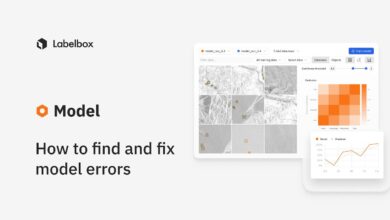
Cloud Security Beefed Up for IBM Blockchain
Cloud security beefed up for IBM Blockchain – that’s the exciting news! IBM’s recent enhancements to its blockchain platform are seriously impressive, boosting security across the board. This isn’t just a minor tweak; we’re talking major upgrades to data encryption, access control, and overall infrastructure, making it a far more secure environment for sensitive transactions. Get ready to dive into the details of how IBM is raising the bar for blockchain security in the cloud.
This upgrade isn’t just about adding more locks to the door; it’s about a fundamental shift in how IBM approaches security. They’ve leveraged cutting-edge cloud technologies to create a system that’s more resilient to the ever-evolving landscape of cyber threats. We’ll explore the specifics of these advancements, comparing them to previous iterations and examining how they tackle common blockchain vulnerabilities.
We’ll also look at the real-world impact on data privacy and compliance, along with some compelling use cases that highlight the power of this enhanced security.
IBM Blockchain’s Security Enhancements
IBM’s blockchain platform has undergone significant security improvements, bolstering its resilience against various threats and enhancing its suitability for enterprise-level deployments. These advancements build upon previous iterations, leveraging cutting-edge cryptographic techniques and robust architectural designs to create a more secure and trustworthy environment for managing sensitive data and transactions.
Enhanced Cryptographic Algorithms and Key Management
IBM Blockchain incorporates advanced cryptographic algorithms, including elliptic curve cryptography (ECC) for digital signatures and key exchange. This provides superior security compared to older, less robust algorithms. Furthermore, sophisticated key management systems are integrated, offering features like hardware security modules (HSMs) for secure key storage and management, reducing the risk of unauthorized access or compromise. The transition from less secure cryptographic methods in earlier versions to these more robust algorithms represents a substantial leap forward in security.
This directly addresses common vulnerabilities like private key theft, which can lead to unauthorized transactions and data breaches. The use of HSMs significantly minimizes the risk of key compromise through software vulnerabilities or physical attacks.
Improved Data Confidentiality and Integrity
IBM’s blockchain platform employs various techniques to ensure data confidentiality and integrity. Data encryption, both at rest and in transit, protects sensitive information from unauthorized access. Furthermore, sophisticated hashing algorithms and Merkle trees are used to ensure data integrity, detecting any unauthorized modifications. Compared to earlier versions, the platform now supports more granular control over data access and permissions, allowing organizations to implement fine-grained authorization policies.
This heightened level of control directly mitigates risks associated with data breaches and unauthorized alterations, ensuring the trustworthiness of the blockchain’s immutable ledger.
Advanced Access Control and Authorization
IBM Blockchain’s access control mechanisms have been significantly enhanced. The platform supports role-based access control (RBAC), allowing organizations to define specific roles with varying levels of permissions. This granular control over access helps prevent unauthorized users from interacting with sensitive data or transactions. Furthermore, advanced auditing capabilities provide a detailed log of all activities on the blockchain, facilitating security monitoring and incident response.
Previous versions lacked the same level of fine-grained access control, making them more vulnerable to insider threats and unauthorized access. The enhanced auditing capabilities offer significantly improved accountability and transparency.
Enhanced Network Security and Resilience
IBM Blockchain’s network security has been strengthened through various measures, including robust network segmentation and intrusion detection systems. These mechanisms help protect the blockchain network from external attacks and unauthorized access. Furthermore, the platform supports various consensus mechanisms, providing flexibility and resilience against network disruptions or attacks. In previous versions, network security was less robust, leaving the platform more susceptible to denial-of-service attacks and other network-based threats.
The improved network security and resilience significantly enhance the overall security posture of the blockchain network.
Comparison of Security Features
The following table compares the security features of IBM Blockchain with other major blockchain platforms (note: specific features and implementations may vary depending on the version and configuration):
| Feature | IBM Blockchain | Ethereum | Hyperledger Fabric |
|---|---|---|---|
| Consensus Mechanism | Various (e.g., Raft, PBFT) | Proof-of-Work/Proof-of-Stake | Various (e.g., Raft, Kafka) |
| Cryptography | ECC, HSM support | ECC | Configurable |
| Access Control | RBAC, granular permissions | Account-based | RBAC, granular permissions |
| Auditing | Detailed transaction logs | Public transaction history | Configurable auditing |
Cloud Infrastructure’s Role in Beefed-Up Security

IBM’s cloud infrastructure plays a crucial role in bolstering the security of its blockchain solutions. By leveraging its robust cloud platform, IBM integrates multiple layers of security, enhancing the confidentiality, integrity, and availability of blockchain networks. This goes beyond simply hosting the blockchain; it involves proactive security measures built into the very fabric of the cloud environment.IBM’s cloud infrastructure contributes to blockchain security through a multi-faceted approach.
It’s not just about providing compute and storage; it’s about integrating security at every level, from the physical data centers to the application layer. This layered approach significantly reduces vulnerabilities and enhances the overall resilience of the blockchain system.
Cloud-Based Security Technologies Used to Protect IBM Blockchain
IBM utilizes a range of cloud-based security technologies to protect its blockchain deployments. These technologies work in concert to create a robust security posture. For example, IBM employs advanced encryption techniques, both at rest and in transit, to safeguard sensitive data. Intrusion detection and prevention systems continuously monitor the network for malicious activity, while access control mechanisms, such as role-based access control (RBAC), restrict access to sensitive data and functionalities based on user roles and permissions.
Furthermore, IBM’s cloud platform incorporates regular security audits and vulnerability scanning to identify and address potential weaknesses proactively. These measures, combined with rigorous security protocols, provide a high level of protection for IBM Blockchain deployments.
Data Encryption and Access Control in IBM Blockchain
Data encryption and access control are paramount to the security of IBM Blockchain deployments within the cloud infrastructure. Data encryption, using techniques like AES-256, ensures that even if data is compromised, it remains unreadable without the appropriate decryption key. This protects the confidentiality of sensitive information stored on the blockchain. Access control mechanisms, such as RBAC, ensure that only authorized users and applications can access specific data and functionalities within the blockchain network.
This granular control limits the potential impact of any security breach, as unauthorized access is prevented. Multi-factor authentication (MFA) further enhances security by requiring multiple forms of verification before granting access. This layered approach to data protection is critical for maintaining the integrity and confidentiality of the blockchain.
Potential Security Risks and Mitigation Strategies
While cloud-based deployments offer numerous advantages, they also present unique security challenges. Potential risks include data breaches, denial-of-service attacks, and insider threats. IBM mitigates these risks through various strategies. For example, robust firewalls and intrusion detection systems protect against external attacks, while regular security audits and penetration testing identify and address vulnerabilities. Data loss prevention (DLP) tools prevent sensitive data from leaving the controlled environment.
Furthermore, IBM employs rigorous access control policies and monitoring to detect and respond to insider threats. The combination of proactive security measures and reactive incident response capabilities significantly reduces the likelihood and impact of security breaches.
Diagram Illustrating Interaction Between IBM Cloud Infrastructure and Blockchain Security Measures
The diagram would depict a layered architecture. At the bottom would be the physical infrastructure: IBM’s data centers, featuring physical security measures like access controls and environmental monitoring. Above this would be the virtual infrastructure: virtual machines, networks, and storage, protected by virtual firewalls and intrusion detection systems. The next layer would represent the IBM Cloud platform services, including security services such as encryption, key management, and identity and access management (IAM).
Finally, at the top, would be the IBM Blockchain deployment itself, protected by blockchain-specific security features like consensus mechanisms and smart contract security. Arrows would indicate the flow of data and the interaction between the layers, showing how each layer contributes to the overall security of the blockchain. For instance, an arrow would show data encrypted at the platform services layer before being stored on the blockchain, and another arrow would show the IAM service controlling access to the blockchain.
The diagram would visually represent the integrated and layered security approach that IBM employs.
Impact on Data Privacy and Compliance: Cloud Security Beefed Up For Ibm Blockchain
Beefing up cloud security for IBM Blockchain significantly enhances data privacy and ensures compliance with various regulations. The improvements aren’t just about adding layers of encryption; they’re about building a system designed from the ground up with privacy and compliance at its core. This translates to increased trust and confidence for businesses leveraging this technology to manage sensitive data.The enhanced security measures directly impact data privacy by minimizing the risk of unauthorized access, use, disclosure, disruption, modification, or destruction of protected health information (PHI) or personally identifiable information (PII).
This is achieved through a multi-layered approach incorporating robust encryption, access controls, and audit trails, all crucial for maintaining data integrity and confidentiality.
Compliance Standards Addressed
IBM’s enhanced blockchain security addresses a range of compliance standards, including GDPR (General Data Protection Regulation), HIPAA (Health Insurance Portability and Accountability Act), and others depending on specific client needs and industry regulations. For instance, the granular access controls implemented help organizations meet GDPR’s data subject access request requirements, ensuring individuals have control over their data. Similarly, the rigorous audit trails and data encryption capabilities contribute to HIPAA compliance by providing a detailed record of data access and usage, essential for demonstrating compliance with the act’s stringent privacy rules.
The platform’s design facilitates compliance auditing, making it easier for organizations to demonstrate adherence to relevant regulations.
IBM’s beefed-up cloud security for its blockchain platform is a crucial step, especially considering the sensitive data involved. This highlights the growing need for robust cloud security posture management, a topic explored in detail in this insightful article on bitglass and the rise of cloud security posture management , which emphasizes proactive security measures. Ultimately, strengthening cloud security, whether for blockchain or other applications, remains paramount in today’s threat landscape.
Mechanisms for Protecting Sensitive Data
Several mechanisms are employed to safeguard sensitive data within IBM Blockchain. Data encryption, both in transit and at rest, is a cornerstone of this security architecture. This means that data is encrypted before being transmitted across networks and remains encrypted while stored on the blockchain. Furthermore, robust access controls, based on role-based access management (RBAC), limit access to sensitive data only to authorized personnel.
This granular control ensures that only individuals with legitimate business needs can access specific data sets. Regular security audits and vulnerability assessments further enhance the security posture, identifying and addressing potential weaknesses before they can be exploited. The immutable nature of the blockchain itself provides an additional layer of security, as any tampering with data would be immediately apparent.
Best Practices for Maintaining Data Privacy When Using IBM Blockchain
Maintaining data privacy requires a proactive and multi-faceted approach. It’s not just about relying on the platform’s inherent security features; it’s about implementing best practices within your organization’s processes.
Here are some key best practices:
- Implement strong access control policies: Limit access to data based on the principle of least privilege. Only grant access to individuals who absolutely need it for their job function.
- Regularly review and update access controls: Personnel changes and evolving business needs require periodic reviews of access rights to ensure continued data security.
- Utilize data masking and anonymization techniques: Where possible, mask or anonymize sensitive data to reduce the risk of exposure.
- Employ robust encryption methods: Ensure all data, both in transit and at rest, is protected with strong encryption algorithms.
- Maintain comprehensive audit trails: Track all data access and modifications to facilitate auditing and incident response.
- Conduct regular security assessments: Regularly assess your security posture to identify and address potential vulnerabilities.
- Stay informed about evolving compliance requirements: Keep abreast of changes in relevant regulations and adapt your security practices accordingly.
Use Cases and Real-World Applications

The enhanced security features of IBM Blockchain, particularly when coupled with robust cloud infrastructure, are transforming various industries. These improvements are not just theoretical advancements; they’re directly impacting real-world applications by increasing trust, reliability, and efficiency in data management and transactions. The following examples illustrate how these security enhancements are being utilized and the significant impact they have.
Supply Chain Management
Improved traceability and transparency are key benefits of blockchain in supply chain management. However, security is paramount to ensure the integrity of product information and prevent counterfeiting or fraud. IBM’s enhanced security measures, including robust encryption and access controls, address these challenges. For instance, a food producer could use IBM Blockchain to track its products from farm to table, recording every step of the journey with tamper-proof data.
If a contamination issue arises, the blockchain’s immutable record allows for rapid identification of the source and affected products, minimizing risks and maintaining consumer trust. The enhanced security prevents malicious actors from altering the data, thereby maintaining the accuracy and integrity of the supply chain information.
Healthcare Data Management
Sharing sensitive patient data securely and efficiently is a significant challenge in healthcare. IBM Blockchain, with its improved security features, offers a solution for securely storing and exchanging medical records. Imagine a scenario where multiple healthcare providers need to access a patient’s medical history. Using IBM Blockchain, this data can be shared selectively and securely, with each access event logged and auditable.
The enhanced encryption and access control mechanisms ensure patient privacy and compliance with regulations like HIPAA. This significantly improves patient trust in data security and interoperability within the healthcare system. A successful implementation of this technology could greatly reduce the risk of data breaches and improve the quality of patient care.
Financial Services
The financial industry relies heavily on secure and transparent transactions. IBM Blockchain’s enhanced security features address the challenges of fraud, data breaches, and regulatory compliance. For example, a bank could use IBM Blockchain to securely manage international payments, reducing processing times and improving transparency. The improved security features ensure the integrity of the transactions and prevent unauthorized access or manipulation of financial data.
This enhances trust among financial institutions and their clients, leading to a more efficient and secure financial ecosystem. The immutability of the blockchain provides a verifiable audit trail, reducing the risk of disputes and improving regulatory compliance.
| Use Case | Security Needs | IBM’s Enhanced Security Solution |
|---|---|---|
| Supply Chain Management | Data integrity, tamper-proof records, prevention of counterfeiting | Robust encryption, access controls, immutable ledger |
| Healthcare Data Management | Patient privacy, secure data sharing, HIPAA compliance | Enhanced encryption, granular access control, audit trails |
| Financial Services | Fraud prevention, secure transactions, regulatory compliance | Strong encryption, secure key management, immutable ledger |
| Digital Identity Management | Secure identity verification, prevention of identity theft | Decentralized identity management, strong authentication mechanisms |
Future Directions and Security Considerations
The security landscape is constantly evolving, and blockchain technology, while inherently secure, is not immune to emerging threats. IBM Blockchain, with its robust architecture, requires ongoing vigilance and proactive measures to maintain its position as a leading secure platform. Future-proofing this technology necessitates a multi-faceted approach encompassing threat prediction, proactive development, and continuous monitoring.
Potential Future Security Threats and Mitigation Strategies
Quantum computing presents a significant long-term threat. Quantum computers, with their vastly increased processing power, could potentially break current cryptographic algorithms used to secure blockchain transactions. Mitigation strategies include exploring and implementing post-quantum cryptography (PQC) algorithms, which are designed to resist attacks from quantum computers. Research into lattice-based cryptography and code-based cryptography is actively underway to develop these PQC solutions.
Another potential threat is sophisticated social engineering attacks targeting administrators or users with access to private keys, potentially leading to unauthorized access or manipulation of the blockchain. Strengthening access controls, implementing multi-factor authentication (MFA), and robust security awareness training for all users are crucial countermeasures. Furthermore, the increasing complexity of smart contracts introduces vulnerabilities that malicious actors could exploit.
Rigorous code auditing, formal verification techniques, and the use of secure development practices throughout the software development lifecycle (SDLC) are vital for mitigating this risk.
Ongoing Research and Development in Blockchain Security
IBM and the broader blockchain community are actively engaged in research and development to enhance security. This includes advancements in consensus mechanisms, moving beyond Proof-of-Work (PoW) towards more energy-efficient and secure alternatives like Proof-of-Stake (PoS) and variations thereof. Research also focuses on improving the scalability and performance of blockchain networks while maintaining security. Sharding, for instance, is a technique that partitions the blockchain into smaller, more manageable parts, improving transaction throughput and reducing latency without compromising security.
IBM’s beefed-up cloud security for its blockchain platform is a game-changer, especially considering the sensitive data often involved. This heightened security is crucial, and complements the development advancements seen in areas like application building. For instance, check out this insightful piece on domino app dev the low code and pro code future , which highlights how easier app development can lead to more secure and robust systems overall.
Ultimately, stronger security in the cloud directly impacts the future of app development and the overall security of blockchain technology.
Furthermore, ongoing research explores the use of zero-knowledge proofs and homomorphic encryption to enhance privacy and confidentiality within blockchain systems. These cryptographic techniques allow for verification of transactions without revealing sensitive data.
The Importance of Ongoing Security Audits and Vulnerability Assessments
Regular security audits and vulnerability assessments are paramount for maintaining the integrity of IBM Blockchain. These audits should involve independent security experts who can identify potential weaknesses and vulnerabilities in the system’s architecture, code, and implementation. Penetration testing, a simulated attack on the system, helps identify exploitable vulnerabilities before malicious actors can discover them. The findings from these assessments should be used to proactively address vulnerabilities and strengthen the overall security posture.
A documented and regularly updated vulnerability management program is essential to ensure timely patching and mitigation of identified risks.
Continuous Monitoring and Threat Detection in Blockchain Security, Cloud security beefed up for ibm blockchain
Continuous monitoring and threat detection are crucial for identifying and responding to security incidents in real-time. This involves implementing robust monitoring systems that track blockchain activity, network traffic, and system logs for any suspicious behavior. Anomaly detection techniques, using machine learning and artificial intelligence, can help identify unusual patterns that might indicate a security breach. Security Information and Event Management (SIEM) systems can consolidate security data from various sources, providing a centralized view of the blockchain’s security posture.
Furthermore, a well-defined incident response plan is necessary to ensure a swift and effective response to any security incidents.
A Future-Oriented Security Strategy for IBM Blockchain
A comprehensive security strategy for IBM Blockchain must adopt a layered approach, combining multiple security controls to create a robust defense. This strategy should prioritize proactive threat identification and mitigation, continuous monitoring and incident response, and a commitment to ongoing research and development. Key components include:
- Proactive Threat Intelligence: Regularly assess emerging threats and vulnerabilities, incorporating threat intelligence feeds and proactive security research.
- Robust Access Control: Implement strict access control measures, including multi-factor authentication, role-based access control, and regular security audits of user permissions.
- Secure Development Lifecycle (SDLC): Integrate security into every phase of the SDLC, from design and development to testing and deployment.
- Continuous Monitoring and Incident Response: Implement real-time monitoring, anomaly detection, and a well-defined incident response plan to quickly address security incidents.
- Post-Quantum Cryptography (PQC) Adoption: Proactively research and implement PQC algorithms to mitigate the threat of quantum computing.
- Regular Security Audits and Penetration Testing: Conduct regular security audits and penetration testing to identify and address vulnerabilities.
This multi-layered approach, coupled with ongoing collaboration with the broader blockchain community, will ensure IBM Blockchain remains a secure and reliable platform for years to come.
Closing Summary
IBM’s commitment to beefing up cloud security for its blockchain platform is a game-changer. The improvements aren’t just incremental; they represent a significant leap forward in protecting sensitive data and ensuring compliance. By combining robust cloud infrastructure with innovative security measures, IBM is setting a new standard for trust and reliability in the blockchain space. This enhanced security isn’t just about protecting data today; it’s about building a future-proof system capable of withstanding tomorrow’s threats.
It’s clear that IBM is serious about securing its blockchain future, and that’s good news for everyone.
Frequently Asked Questions
What specific encryption methods does IBM use to protect data on its blockchain?
IBM employs a multi-layered approach, utilizing advanced encryption techniques like AES-256 and potentially others depending on the specific implementation and client needs. The exact methods aren’t always publicly disclosed for security reasons.
How does IBM’s enhanced security impact the cost of using its blockchain platform?
While the enhanced security features likely involve increased investment in infrastructure and maintenance, the exact cost impact varies based on usage and specific service levels. It’s best to contact IBM directly for pricing details.
Are there any limitations to IBM’s enhanced blockchain security measures?
While the improvements are substantial, no security system is perfect. Potential vulnerabilities could still exist, and ongoing monitoring and updates are crucial. The system’s security is also dependent on the user’s adherence to best practices.





